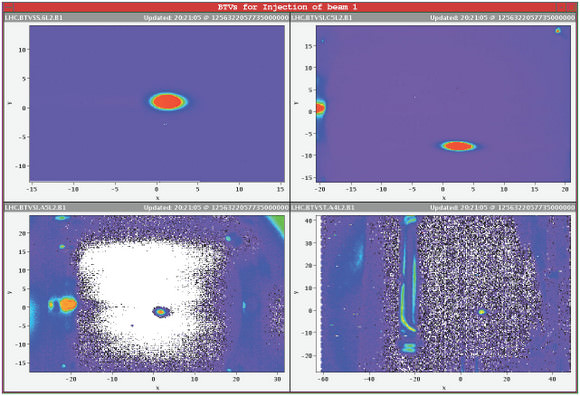[/caption]
The Large Hadron Collider reached an important milestone last weekend as a beam of ions was injected into the clockwise beam pipe. This is the first time particles have been inside the collider since September, 2008 when physicists were forced to shut down the system because of a massive failure. According to a CERN press release, lead ions were placed in the clockwise beam pipe on Friday October 23, but did not travel along the whole circumference of the LHC. CERN officials still hope for a restart in 2009, with the first circulating beam likely to be injected in mid-November, and the first high energy collisions occurring around mid-December.
CERN said that later last Friday the first beam of protons followed the same route — and then on Saturday protons were sent through the LHCb detector.
They reported all settings and parameters showed a perfect functioning of the machine. In the coming weeks, physicists hope to have the first circulating beam. Then hunt for the elusive Higgs particle will recommence.
Here is an interview with CERN director general Rolf-Dieter Heuer about the switch-on of the LHC.
Sources: CERN, Physics World


awesome, cant wait to see what great new discoveries come in the following months.
Sweet mother. I must say, finding the Higgs is almost a given. What I can’t wait to see is if they find the multiple Higgs particles that are predicted by theories going beyond the standard model like supersymmetry and whatnot.
One way or the other, this thing will hit paydirt. Oooh baby.
I wouldn’t say finding the Higgs was a given…. I’ll bet what ever they do find will only open up a whole new class of particles to try and find and questions that blow every ones minds!
Every time we find something new or answer a mystery, we have thousands more to look into. That’s what makes this subject so awesome.
Fire the puppy up and let’s ROCK the HADRON!!!!
The Higss field/particle is related to criticality in physics that is pretty generic. Peter Higgs even propsed the particle field as an anologue to superconductivity physics. The first physics with this characteristic was advanced by Pierre Curie as a way to understand phase transitions between ferromagnetic and paramagnetic properties of metals with temperature variation. So something at least similar to the Higgs field is likely to emerge.
LC
WE ARE ALL GOING TO DIIIIEEEEE……
sorry, somehow I felt this should have been said!
Anyway, hopefully they get the LHC up and running properly. We should meet again, then, in one year and see what we have found!
Great sarcastic post, Dr Flimmer 🙂 You should a have a promising career ahead of you, with your quick, thoughtful insights in this astrophysical conundrum and other questions. If only supercomputers were readily available when I took college-level astrophysics in the late ’70s and early ’80s, And with PanSTARRS 4.0 and the LSST coming on line soon with enormous amounts of information being amassed, collected & correlated as well as close scrutiny of the observations. The golden age of astronomy is upon us!